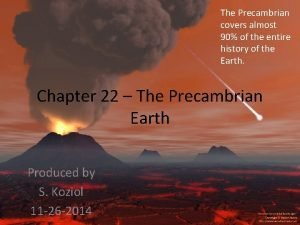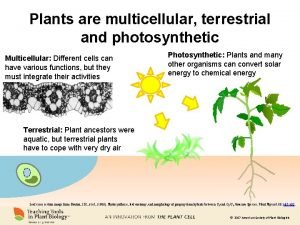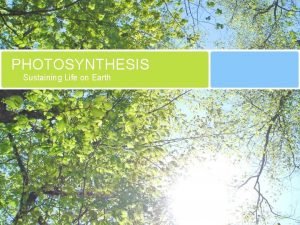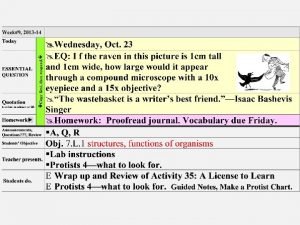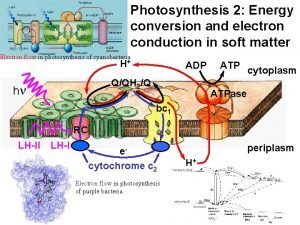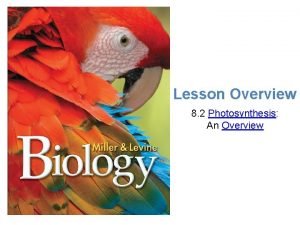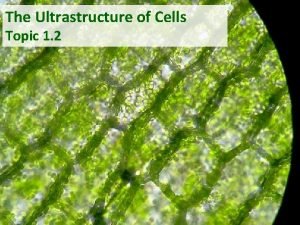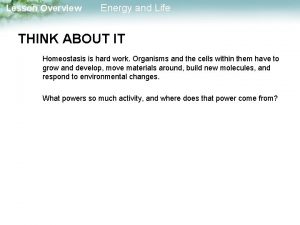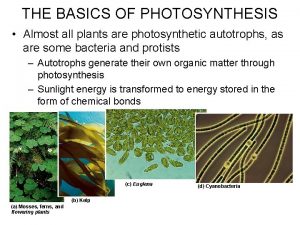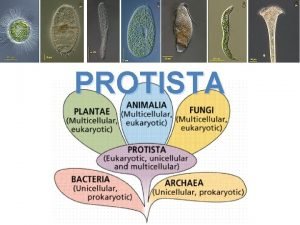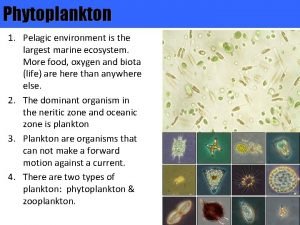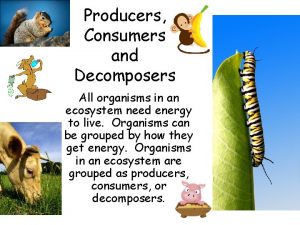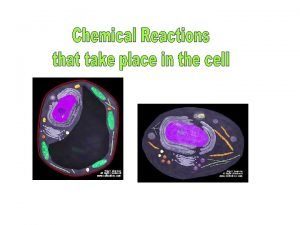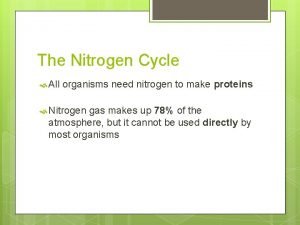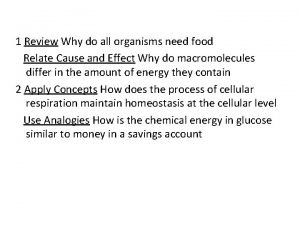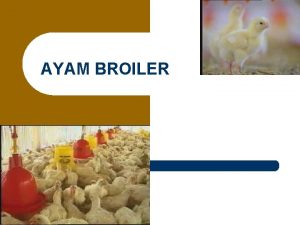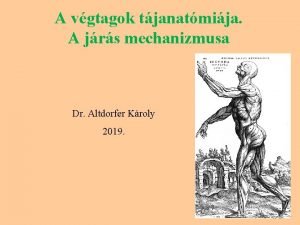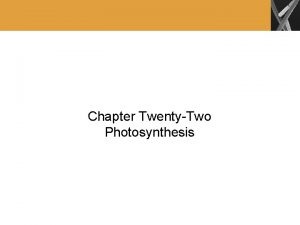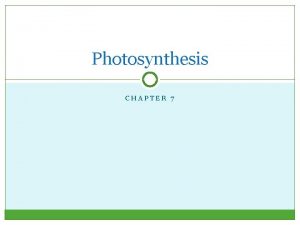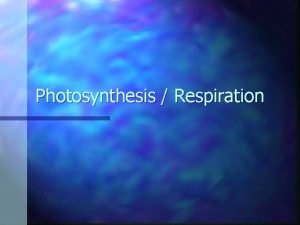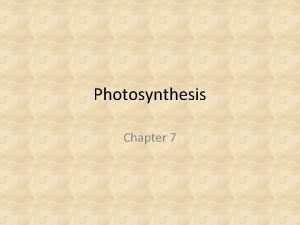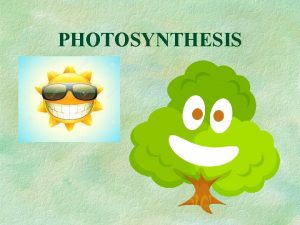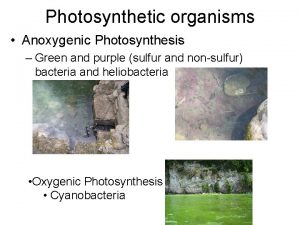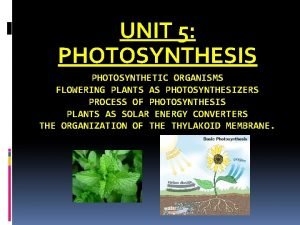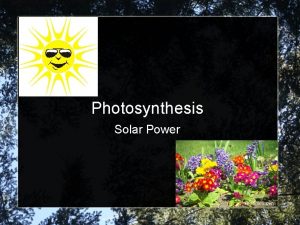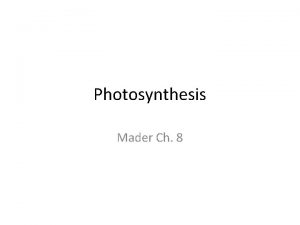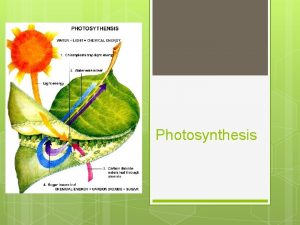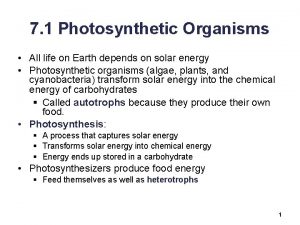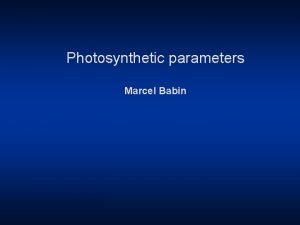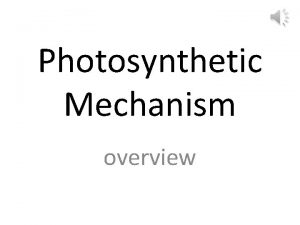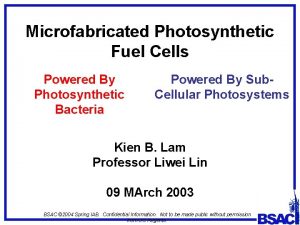PHOTOSYNTHESIS Photosynthetic Organisms l l All life on




























- Slides: 28

PHOTOSYNTHESIS

Photosynthetic Organisms l l All life on Earth depends on a star 93 million miles away Provides photosynthesizers with solar energy Photosynthesis: – A process that captures solar energy – Transforms solar energy into chemical energy – Energy ends up stored in a carbohydrate Photosynthesizers produce all food energy – Only 42% of sun’s energy directed towards Earth reaches surface – Of this, only 2% is captured by photosynthesizers – Of this, only a tiny portion results in biomass

Photosynthesis l l Photosynthesis takes place in the green portions of plants – Leaf of flowering plant contains mesophyll tissue – Cells containing chloroplasts – Specialized to carry on photosynthesis CO 2 enters leaf through stomata – Diffuses into chloroplasts in mesophyll cells – In stroma, CO 2 combined with H 2 O to form C 6 H 12 O 6 (sugar) – Energy supplied by light

Leaves and Photosynthesis

Photosynthetic Pigments l l Pigments: – Chemicals that absorb some colors in rainbow more than others – Colors least absorbed reflected/transmitted most Absorption Spectra l Graph showing relative absorption of the various colors of the rainbow l Chlorophyll is green because it absorbs much of the reds and blues of white light

Photosynthetic Pigments

Photosynthetic Reactions: Overview l l Light Reaction: – Chlorophyll absorbs solar energy – This energizes electrons – Electrons move down electron transport chain l Pumps H+ into thylakoids l Used to make ATP out of ADP and NADPH out of NADP Calvin Cycle Reaction – CO 2 is reduced to a carbohydrate – Reduction requires the ATP and NADPH produced above

Photosynthesis Overview

Photosynthetic Reactions: The Light Reactions l l Light reactions consist of two alternate electron pathways: – Noncyclic electron pathway – Cyclic electron pathway Capture light energy with photosystems – Pigment complex helps collect solar energy like an antenna – Occur in the thylakoid membranes l Both pathways produce ATP l The noncyclic pathway also produces NADPH

Light Reactions: The Noncyclic Electron Pathway l l l Takes place in thylakoid membrane Uses two photosystems, PS-I and PS-II PS II captures light energy Causes an electron to be ejected from the reaction center (chlorophyll a) – Electron travels down electron transport chain to PS I – Replaced with an electron from water – Which causes H+ to concentrate in thylakoid chambers – Which causes ATP production PS I captures light energy and ejects an electron – Transferred permanently to a molecule of NADP+ – Causes NADPH production

Light Reactions: Noncyclic Electron Pathway

Light Reactions: The Cyclic Electron Pathway l Uses only photosystem I (PS-I) l Begins when PS I complex absorbs solar energy l Electron ejected from reaction center l – Travels down electron transport chain – Causes H+ to concentrate in thylakoid chambers – Which causes ATP production – Electron returns to PS-I (cyclic) Pathway only results in ATP production

Light Reactions: Cyclic Electron Pathway

Organization of the Thylakoid Membrane l l PS II: – Pigment complex and electron-acceptors – Adjacent to an enzyme that oxidizes water – Oxygen is released as a gas Electron transport chain: – Consists of cytochrome complexes – Carries electrons between PS II and PS I – Also pump H+ from the stroma into thylakoid space PS I: – Pigment complex and electron acceptors – Adjacent to enzyme that reduces NADP+ to NADPH ATP synthase complex: – Has a channel for H+ flow – Which drives ATP synthase to join ADP and Pi

Organization of a Thylakoid

ATP Production l l l Thylakoid space acts as a reservoir for hydrogen ions (H+) Each time water is oxidized, two H+ remain in the thylakoid space Electrons yield energy – Used to pump H+ across thylakoid membrane – Move from stroma into the thylakoid space Flow of H+ back across thylakoid membrane – Energizes ATP synthase – Enzymatically produces ATP from ADP + Pi This method of producing ATP is called chemiosmosis

Calvin Cycle Reactions: Overview of C 3 Photosynthesis l. A cyclical series of reactions l Utilizes atmospheric carbon dioxide to produce carbohydrates l Known as C 3 photosynthesis l Involves three stages: l. Carbon dioxide fixation l. Carbon dioxide reduction l. Ru. BP Regeneration

Calvin Cycle Reactions: Carbon Dioxide Fixation l l CO 2 is attached to 5 -carbon Ru. BP molecule – Result in a 6 -carbon molecule – This splits into two 3 -carbon molecules (3 PG) – Reaction accelerated by Ru. BP Carboxylase (Rubisco) CO 2 now “fixed” because it is part of a carbohydrate

The Calvin Cycle: Fixation of CO 2

The Calvin Cycle Reduction of CO 2 In. Line Figure p 125

The Calvin Cycle Regeneration of Ru. BP

Importance of Calvin Cycle l G 3 P (glyceraldehyde-3 -phosphate) can be converted to many other molecules l The hydrocarbon skeleton of G 3 P can form – Fatty acids and glycerol to make plant oils – Glucose phosphate (simple sugar) – Fructose (which with glucose = sucrose) – Starch and cellulose – Amino acids

C 4 Photosynthesis l l In hot, dry climates – Stomata must close to avoid wilting – CO 2 decreases and O 2 increases – O 2 starts combining with Ru. BP instead of CO 2 – Photorespiration, a problem solve in C 4 plants In C 4 plants – Fix CO 2 to PEP a C 3 molecule – The result is oxaloacetate, a C 4 molecule – In hot & dry climates l Avoid photorespiration l Net productivity about 2 -3 times C 3 plants – In cool, moist, can’t compete with C 3

Chloroplast distribution in C 4 vs. C 3 Plants

CO 2 Fixation in C 4 vs. C 3 Plants

CAM Photosynthesis l Crassulacean-Acid Metabolism – CAM plants partition carbon fixation by time l l During the night – CAM plants fix CO 2 – Forms C 4 molecules, – Stored in large vacuoles During daylight – NADPH and ATP are available – Stomata closed for water conservation – C 4 molecules release CO 2 to Calvin cycle

CO 2 Fixation in a CAM Plant

Climatic Adaptation: Photosynthesis l l l Each method of photosynthesis has advantages and disadvantages Depends on the climate C 4 plants most adapted to: – high light intensities l high temperatures l Limited rainfall C 3 plants better adapted to l Cold (below 25 C) l High moisture CAM plants better adapted to extreme aridity – CAM occurs in 23 families of flowering plants – Also found among nonflowering plants
 Which kingdoms have photosynthetic organisms? *
Which kingdoms have photosynthetic organisms? * Tiny, threadlike photosynthetic organisms
Tiny, threadlike photosynthetic organisms Competitive interaction
Competitive interaction Single celled and multi celled organisms
Single celled and multi celled organisms Photosynthetic
Photosynthetic What is a photosynthetic organism
What is a photosynthetic organism Paramecium eyespot
Paramecium eyespot Photosynthetic apparatus
Photosynthetic apparatus Photosynthesis
Photosynthesis Photosynthetic cells
Photosynthetic cells Plant tissue and organs
Plant tissue and organs Photosynthetic cells
Photosynthetic cells Photosynthetic autotroph
Photosynthetic autotroph What kingdom is photosynthetic aquatic and unicellular
What kingdom is photosynthetic aquatic and unicellular Pelagic plankton
Pelagic plankton Name a line containing point a
Name a line containing point a Decomposers and producers
Decomposers and producers Where do all organisms get their energy
Where do all organisms get their energy Why do all organisms need nitrogen
Why do all organisms need nitrogen Why do organisms need food?
Why do organisms need food? The smallest living unit within the human body is
The smallest living unit within the human body is Help ever hurt never
Help ever hurt never Interventi sociali rivolti all'infanzia e all'adolescenza
Interventi sociali rivolti all'infanzia e all'adolescenza Above all powers
Above all powers I work all night i work all day
I work all night i work all day All-to-all personalized communication
All-to-all personalized communication Sistem all in all out
Sistem all in all out Guyon csatorna
Guyon csatorna Silent night holy night all is calm all is bright
Silent night holy night all is calm all is bright

